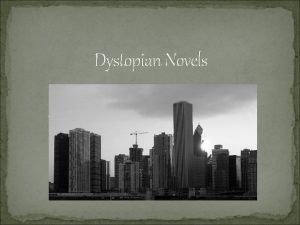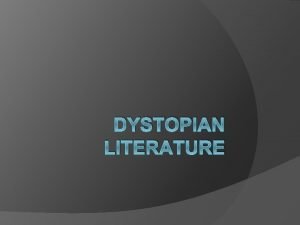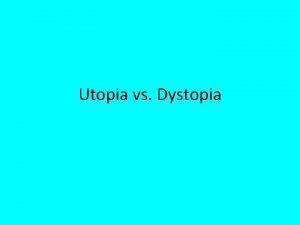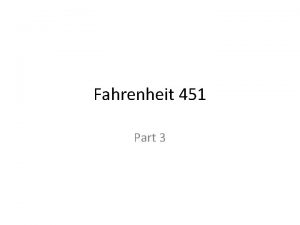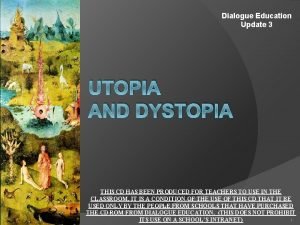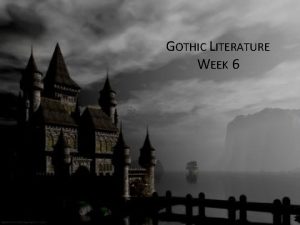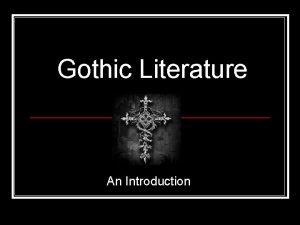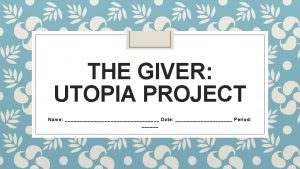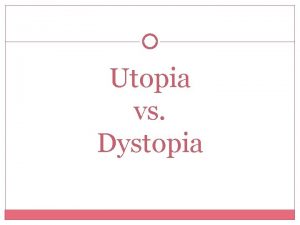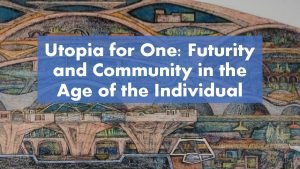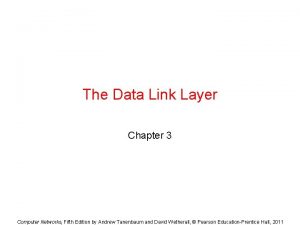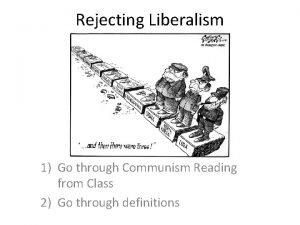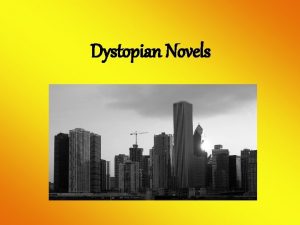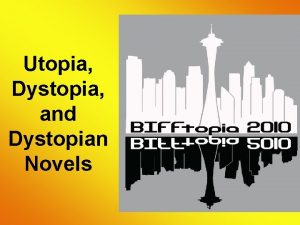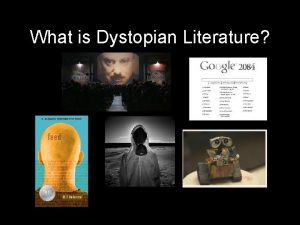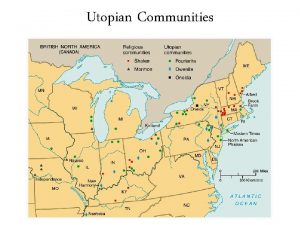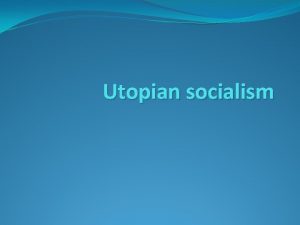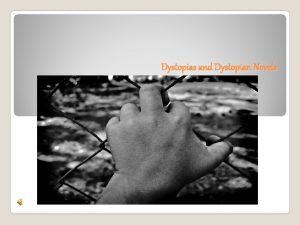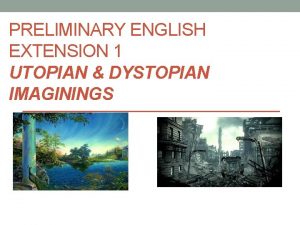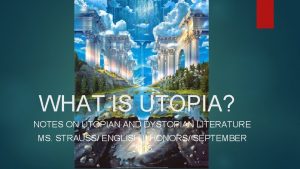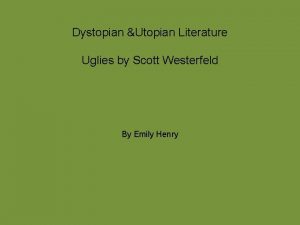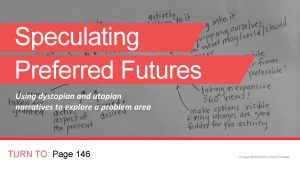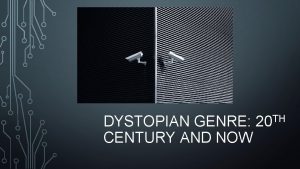Dystopian Novels Definition Check Utopian refers to human
















- Slides: 16

Dystopian Novels

Definition Check: Utopian refers to human efforts to create a hypothetically perfect society. It refers to good but impossible proposals - or at least ones that are difficult to carry out.

Dystopian versus Utopian Dystopian is the opposite of utopian; it is often a utopia gone sour, an imaginary place or state where everything is as bad as it could possibly be.

Dystopian Novels Dystopian novels usually include elements of contemporary society and are seen as a warning against some modern trend. Writers use them as cautionary tales, in which humankind is put into a society that may look inviting on the surface but in reality, is a nightmare.

Characteristics of Dystopian Literature Fictional and futuristic Dystopias serve as warnings to contemporary man Comment on our own current society Strong focus on Technology

When Bradbury wrote 451…. . Anti-communist movement led by Senator Joseph Mc. Carthy—black listed Hollywood actors, book burning, banned books—in the 1940 s-1950 s (Mc. Carthy Era). Cold War Era Korean War Rise of TV Increase of technology

The 1950 s and the TV 1953 - TVs began showing up in homes Americans quickly fell in live and everyone managed to purchase a TV for their house. Radios and Movie Theatres lost a lot of business. Ray Bradbury witnessed this, and his vision of how TV could eventually affect American life became a fundamental theme of Fahrenheit 451.

1950 s and Conformity Suburbs began to develop. Hairstyles, clothing, thinking, and behavior were all standardized. Individuality was frowned upon or laughed at.

House Wife Stereotype of the 1950 s The housewife is remembered as being pretty, made up at all times of the day, the cook and maid, consumer, mother, and loyal wife. Where did all these stereotypes come from? Simply answered, they came from the conservative and conformist decade that produced the housewife, the 1950 s.

The 1950’s Housewife and Her Soaps In 1988, H. Wesley Kenney, then Executive Producer of General Hospital, said to The New York Times: I think people like stories that continue so they can relate to these people. They become like a family, and the viewer becomes emotionally involved. There seem to be two attitudes by viewers. One, that the stories are similar to what happened to them in real life, or two, thank goodness that isn't me.

Fahrenheit 451 by Ray Bradbury (1953) The story takes place in the twenty-first century, in an America where books are banned. Society feels that “opinion” books contain conflicting theories which are disruptive to society. The penalty for owning one is having one's house and books burnt by "firemen. " 451° F is stated as “the temperature at which book paper catches fire and burns…”

Themes Censorship Knowledge Vs. Ignorance Literature and Writing Technology and Modernization Rules and Order

Narration Third-person, limited omniscient; follows Montag’s point of view, often articulating his interior monologues

Literary Devices Symbolism – A symbol in literature is the use of one thing to represent an entire set of ideas. In this novel the central symbol is that of fire representing the extinguishing of thinking, imagining, and appreciating. Alliteration – Alliteration is the repetition of one letter sound in order to produce a desired effect. Metaphor – A metaphor is an implied comparison between two seemingly unlike objects. Simile – A simile is a comparison of two seemingly unlike objects which uses the words "like" or "as. " Irony – A situation is ironic when it becomes the exact opposite of what is intended. Foreshadowing – These are the author’s hints as what is to take place in future time within the novel

Relation to the Real World In the novel, Bradbury combined several issues of his contemporary society: The burnings of books in Nazi Germany. The explosion of a nuclear weapon. • The author also addresses the concern that the presence of fast cars, loud music, television, and advertisements creates a lifestyle with too much stimulation where no one has the time to concentrate. • He also addresses concerns about censorship at the expense of personal expression.

Summary The dystopian literature of the period reflected the many concerns that resonated throughout the twentieth century. The concept of a dystopia was introduced to help reveal the potential consequences of a utopia turning against itself.
 Dystopian genre characteristics
Dystopian genre characteristics Dystopia definition in literature
Dystopia definition in literature What is a dystopian society
What is a dystopian society Themes in part 3 of fahrenheit 451
Themes in part 3 of fahrenheit 451 Utopian vs dystopian
Utopian vs dystopian Utopia literary definition
Utopia literary definition Gothic literature definitions
Gothic literature definitions Definition of the gothic genre
Definition of the gothic genre The giver utopia project
The giver utopia project Data link layer design issues
Data link layer design issues Site:slidetodoc.com
Site:slidetodoc.com Fictional character examples
Fictional character examples Francis ford selffinance 120m utopian
Francis ford selffinance 120m utopian A utopian simplex protocol
A utopian simplex protocol Communism
Communism Fictional character
Fictional character American gothic examples
American gothic examples
